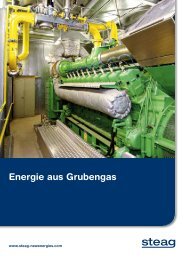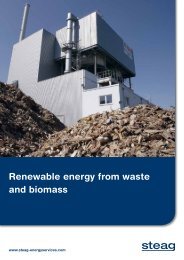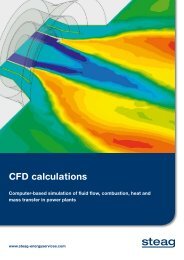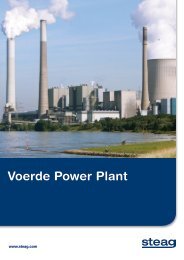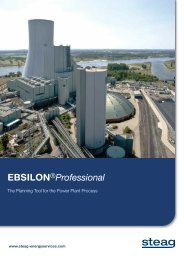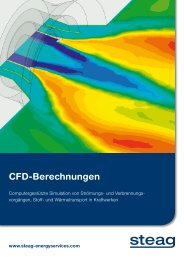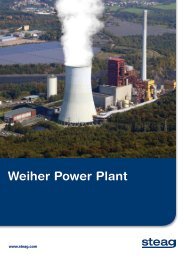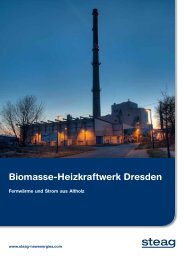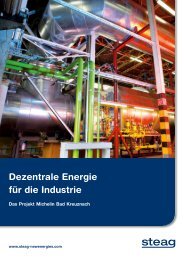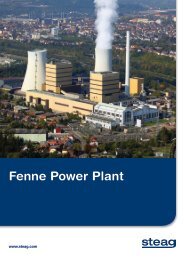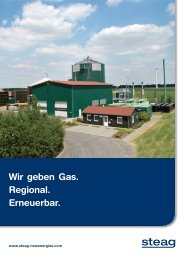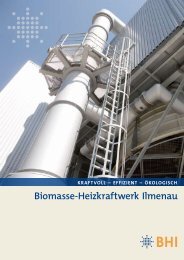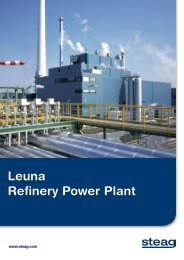Create successful ePaper yourself
Turn your PDF publications into a flip-book with our unique Google optimized e-Paper software.
Lünen <strong>Power</strong> <strong>Plant</strong><br />
www.steag.com
<strong>Power</strong> and heat for the future<br />
Energy for the railways<br />
and residents<br />
As fifth biggest electricity producer in Germany, with ultramodern<br />
power plants in and outside Germany and a variety of<br />
services, <strong>STEAG</strong> GmbH safeguards the energy supply of the<br />
future – reliably, efficiently, and with low environmental impact.<br />
<strong>STEAG</strong> blazes the trail for the energy sources biomass,<br />
biogas, mine gas, geothermics, wind and solar thermics. The<br />
engineers of <strong>STEAG</strong> Energy Services GmbH develop, build<br />
and operate power plants all over the world and are experts<br />
for the modernization of existing plants and for made-tomeasure<br />
energy supply which goes easy on the climate and<br />
at the same time is economical.<br />
<strong>Power</strong> plants at home and abroad<br />
<strong>STEAG</strong> operates eleven power plants at ten locations in<br />
Germany with an installed capacity of about 7,500 MW; nine<br />
of these plants use hard coal as primary energy source. At<br />
two sites, each of which integrates an industrial power plant,<br />
refinery by-products also are used to produce steam, compressed<br />
air and electricity. Most of the electricity from hard<br />
coal is supplied to industrial and public utilities. The customers<br />
include RWE, EnBW and Deutsche Bahn, the German<br />
Railways. Where there is a demand for it, cogeneration –<br />
the simultaneous production of power and useful heat – is<br />
practiced. This heat either is used for heating purposes or<br />
is purchased by industrial enterprises in the form of process<br />
heat for their production processes. Outside Germany, too,<br />
the company contributes to public power supply with three<br />
hard-coal-fired power plants, capacity about 1,700 MW, in<br />
Turkey, Colombia and the Philippines. The efficient power<br />
plants of <strong>STEAG</strong> make an active contribution to a secure and<br />
sustainable supply of energy.<br />
With a gross capacity of 507 megawatts (MW) the Lünen<br />
power plant with its two units generates around 1.6 billion<br />
kilowatt-hours (kWh) of electricity annually. This is enough<br />
to supply the electricity needs of a city with around 400,000<br />
single-family households. Currently, 110 MW of so-called<br />
traction current go to Deutsche Bahn, the German Railways.<br />
To drive their electric trains they require 16 2/3 hertz (Hz)<br />
current.<br />
Households, on the other hand, use 50 Hz current. Simultaneously,<br />
based on the principle of cogeneration the plant<br />
generates about 51 million kWh th<br />
of heat. The parallel production<br />
of heat and electricity improves the degree of utilization of<br />
the input hard coal, i.e., the energy contained in the coal can<br />
be better exploited. Combined heat and power production<br />
consequently makes the cogeneration plant more efficient –<br />
and thus more environment-friendly. <strong>STEAG</strong> supplies the heat<br />
to the Lünen municipal utilities‘ network in the form of district<br />
heating.<br />
Optimal location<br />
The location of the power plant affords optimal conditions for a<br />
plant site: coal for its operations is supplied by Deutsche Bahn,<br />
which delivers as much as 7,500 tons a day. In addition, the<br />
nearby Lippe River ensures the supply of water to the plant.
The power plant process<br />
Up to 500 tons of hard coal per hour can be transferred from<br />
storage to the coal bunker of the Lünen power plant. From<br />
there, in the same period of time as much as 60 tons go to<br />
the coal mills. The mills pulverize the fuel, which is dried with<br />
hot air and then burned in the furnace at temperatures in excess<br />
of 1,200 °C. In unit 7 of the plant, dried sewage sludge<br />
additionally is used as fuel.<br />
During combustion, hot flue gas is formed. As it passes<br />
over kilometers of tubes in the steam generator, the flue gas<br />
heats water to make steam. The steam, which reaches a<br />
temperature of about 530 °C and is under high pressure, is<br />
conducted into a turbine where it impacts the turbine blades<br />
and causes the turbine shaft to rotate. Like a dynamo a<br />
connected generator produces electricity from this motion.<br />
Transformers bring the electricity up to the necessary voltage<br />
and feed it into the grid.<br />
When the steam has finished its work in the turbine it is<br />
conducted into a condenser. This is a large heat exchanger<br />
with many tubes in which cooling water circulates. The<br />
steam comes in contact with the tubes and forms droplets<br />
(condensation), much like humid air on a cold window pane.<br />
The condensed water droplets are collected and pumped<br />
back into the boiler to complete the cycle. In the process the<br />
cooling water from the condenser heats up from about 20 °C<br />
to 30 °C. It is piped into cooling towers where it cascades<br />
down and cools off again. A small portion evaporates and<br />
is replaced by water from the Lippe River. Only pure water<br />
vapor escapes from the cooling towers.<br />
Combined heat and power from Lünen<br />
In addition to electricity, heat is produced in Lünen.<br />
At several points in the turbines, steam is extracted to<br />
heat water under pressure to a temperature as high as<br />
130 °C for district heating purposes.<br />
Protecting the<br />
environment<br />
When coal is fired, flue gases form which contain mainly<br />
particles of ash, dust, nitrogen oxides and sulfur dioxide. For<br />
many years <strong>STEAG</strong> has been using highly effective methods<br />
to reduce the emissions of these substances. When a power<br />
plant is built today, a third of the expenditure goes into environmental<br />
protection, most of it into air pollution control. <strong>STEAG</strong><br />
will make substantial investments in environmental protection<br />
in future too. The emissions of the power plant are continuously<br />
measured. The company‘s environmental protection officers<br />
monitor and evaluate the measurements. In addition they have<br />
independent bodies like the German inspecting authority TÜV<br />
make measurements.<br />
Valuable by-products<br />
The <strong>STEAG</strong> subsidiary <strong>STEAG</strong> <strong>Power</strong> Minerals GmbH is responsible<br />
for recycling the by-products of all <strong>STEAG</strong> hard-coalfired<br />
power plants in Germany. <strong>Power</strong> plant by-products which<br />
originate in the firing process are valuable and are marketed.<br />
The by-products include fly ash, boiler sand, slag tap granulate<br />
and FGD gypsum.<br />
These power plant by-products are environmentally sound and<br />
can be used in almost all applications as construction materials<br />
without impairing the soil or groundwater. Treatment is only<br />
necessary in special cases. In contrast to the natural resources<br />
which are becoming increasingly scarce, power plant byproducts<br />
will be available in the longer term, conserving natural<br />
raw materials.<br />
Site plan<br />
Zufahrt<br />
1 Coal conveyor belts<br />
2 Boilerhouse (steam generator)<br />
with electrostatic preci pitator<br />
3 Turbine house<br />
4 DeNO x<br />
plant<br />
5 Ammonia storage facility<br />
6 Granulate storage area<br />
7 Gypsum silo<br />
8 Fly ash silo<br />
9 Flue gas desulfurization (FGD) plant<br />
10 Stack<br />
11 Cooling tower<br />
12 Coal yard<br />
11<br />
Moltkestraße<br />
3<br />
3<br />
2<br />
3<br />
10<br />
9<br />
2<br />
4<br />
10<br />
9<br />
4<br />
6<br />
8<br />
12<br />
1<br />
Schematic illustration of the power plant process<br />
From the viewpoint of physics, energy is not produced, but merely transformed. The energy is fixed to the coal in chemical form. The coal is burned in the<br />
boiler; the released heat heats up water. This gives rise to hot steam (thermal energy) which drives a turbine (mechanical energy). A connected generator<br />
then transforms this mechanical energy into electricity (electrical energy).<br />
Brunnenstraße<br />
10<br />
1<br />
5<br />
5<br />
5<br />
7
Data and facts *<br />
Installed capacity<br />
Steam rating<br />
Steam pressure<br />
Unit 6: 157 MW<br />
Unit 7: 350 MW<br />
Total: 507 MW (incl. 110 MW traction current)<br />
Unit 6: 560 t / h<br />
Unit 7: 1,060 t / h<br />
Total: 1,620 t / h<br />
Unit 6: 206 bar<br />
Unit 7: 216 bar<br />
Steam temperature about 530 °C<br />
Useful electricity output<br />
District heating (heating supplied)<br />
Annual coal consumption<br />
Steam generator<br />
Turbine unit<br />
Cooling tower<br />
Water vapor escaping from cooling tower<br />
Dust removal<br />
Flue gas desulfurization (FGD)<br />
NO x<br />
removal (DeNO x<br />
)<br />
By-products<br />
about 1.8 billion KWh / a<br />
about 51 million kWh th<br />
/ a<br />
about 700,000 t / 580,000 tce<br />
Unit 6: pulverized coal (PC) fired Benson boiler with dry ash removal and simple reheat<br />
Unit 3: PC-fired Benson boiler, two-pass design, with wet ash removal and simple reheat<br />
Unit 6: 157 MW three-phase condensing turbine<br />
110 MW traction current condensing turbine<br />
Unit 7: 350 MW three-phase condensing turbine with non-regulated extraction<br />
for district heating<br />
Unit 6: open-circuit cooling with discharge cooling tower, height 22 meters<br />
Unit 7: natural-draft cooling tower, height 109 meters<br />
500 m 3 / h<br />
Electrostatic precipitator<br />
Lime slurry scrubbing, gypsum as final product<br />
Unit 6 / 7: low-dust DeNO x<br />
downstream of FGD<br />
Fly ash, granulate, boiler sand, gypsum<br />
A site with a tradition<br />
The history of the Lünen power plant site and its connection<br />
with <strong>STEAG</strong> goes back a long way, to the year 1938, when<br />
the first plants were built to supply electricity to the aluminum<br />
plant of Vereinigte Aluminium-Werke (VAW). In 1953 a<br />
50 MW unit then was put into operation, followed in 1962<br />
by a 150 MW unit (Boiler 10) with an electrostatic precipitator.<br />
In 1966 the „Gemeinschaftskraftwerk Ost GbR“ was<br />
formed. The objective of the involved parties – Eschweiler<br />
Bergwerks-Verein, Harpen-Hoesch, Rheinstahl Energie and<br />
Steinkohlen-Elektrizität AG (<strong>STEAG</strong>) – was to erect a jointly<br />
owned power plant with a capacity of 350 kW at the Lünen<br />
site. The management was entrusted to <strong>STEAG</strong>. In 1968 the<br />
new power plant entered uncharted territory: the first flue<br />
gas desulfurization pilot plant based on the activated coke<br />
process was put into operation there. In 1971 the <strong>STEAG</strong>-<br />
Bischoff sulfur dioxide scrubbing plant took up service. The<br />
350 MW unit had already gone on-line in 1970. In 1973 a<br />
new 170 MW unit followed. This was the first power plant<br />
unit to use pressure coal gasification and an integrated<br />
combined gas and steam turbine process. One year later the<br />
first flue gas desulfurizing pilot plant based on the lime slurry<br />
scrubbing process was put into service. Since 2003 the power<br />
plant also supplies district heating to Lünen households.<br />
Construction and initial start-up<br />
Operator<br />
Owner<br />
1938–1942: range-type power plant, 8 boilers + 4 x 45 MW turbine generators<br />
1954: 50 MW unit<br />
1962: 150 MW unit (Unit 6)<br />
1970: 350 MW unit (Unit 7)<br />
1973: 170 MW combined-cycle plant (pressure coal gasification)<br />
1984: 110 MW traction current turbine generator added to 150 MW unit<br />
<strong>STEAG</strong> GmbH<br />
<strong>STEAG</strong> GmbH<br />
<strong>STEAG</strong> refers to the gross maximum capacity under nominal<br />
conditions as installed capacity. This is the continuous<br />
output that can be attained under normal conditions. It is<br />
limited by the weakest part of the plant (bottleneck), is determined<br />
by measurement and converted to normal conditions;<br />
stated in MW, calculated as MW electric and equivalent<br />
(thermal output).<br />
The standard coal equivalent or ton of coal equivalent<br />
(tce) is a commonly used unit of measure in Central Europe,<br />
though not a statutory unit of measure, to compare the energy<br />
content of primary energy sources. 1 ton coal equivalent =<br />
29.3076 gigajoules (GJ) = 8.141 thermal megawatt-hours<br />
(MWh th<br />
).<br />
* as at December 31, 2011
<strong>STEAG</strong> GmbH<br />
Rüttenscheider Strasse 1–3<br />
45128 Essen<br />
Germany<br />
Phone +49 201 801-00<br />
Fax +49 201 801-6388<br />
Email info@steag.com<br />
www.steag.com<br />
Kraftwerk Lünen<br />
Moltkestrasse 215<br />
44536 Lünen<br />
Germany<br />
Phone +49 2306 109-222<br />
Fax +49 2306 109-1236<br />
Email kraftwerk.luenen@steag.com<br />
V-UK, as at June 2012



